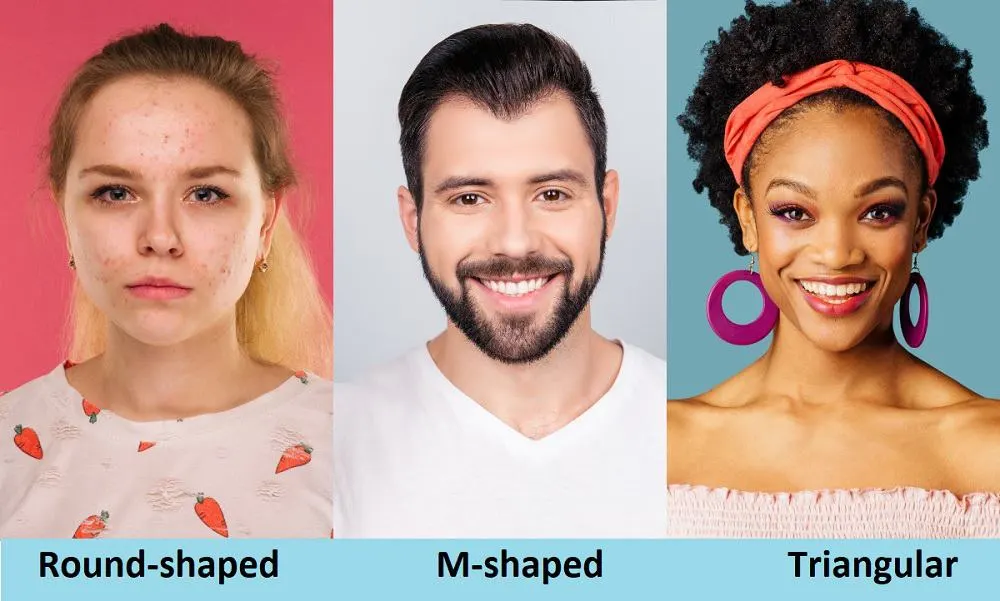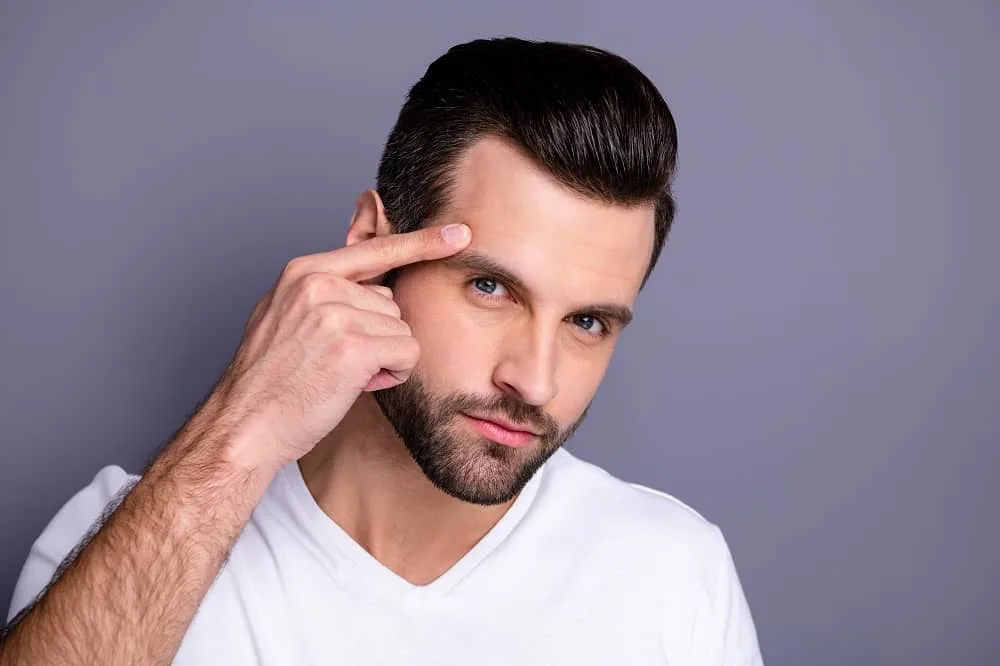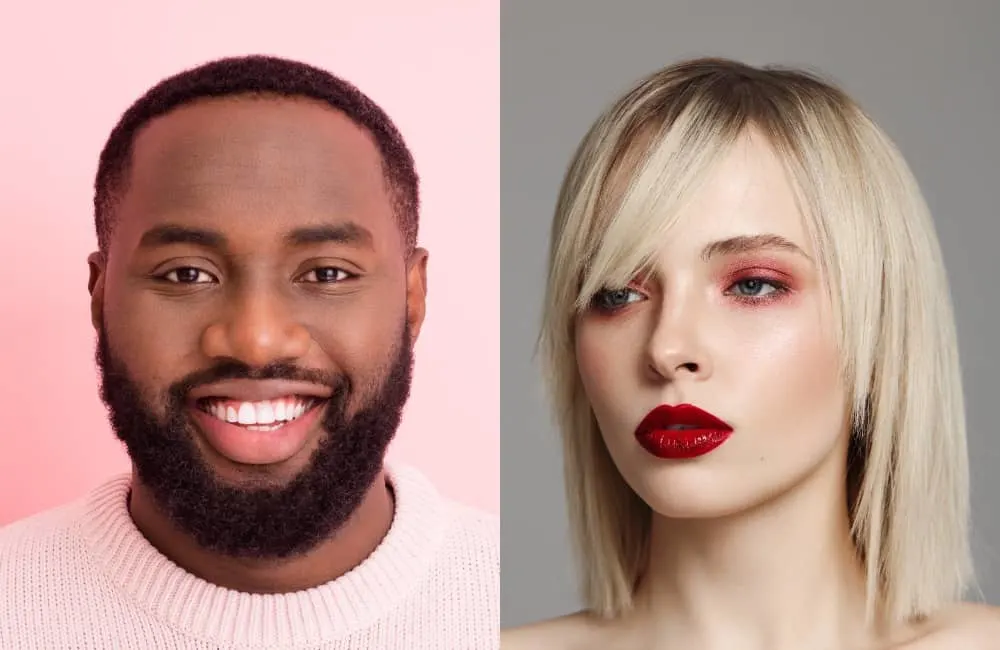If you want to learn whether or not you have a prominent forehead, you need to understand that foreheads come in different shapes. Often, people will mistake a large forehead for one that is irregular or rectangular.
How to Tell If You Have a Big Forehead

There are five typical forehead shapes.
- Round
- M-shaped
- Rectangular
- Bell-shaped
- Triangular
For people with a round-shaped forehead, the crown of their head will look like a half-circle. This is the third most common shape among men (31%) and the second in women (28%).
M-shaped foreheads are closely associated with the widow’s peak, a triangle of hair emerging from your hairline into your forehead. The widow’s peak forms an M-shape between the hairline and the brow. It is the most common shape among men (46%) and third among women (19%).
Rectangular foreheads are self-explanatory but can appear more square if a person has a narrow face. Around 31% of men have rectangular foreheads, and 30% of women have them.
Bell-shaped is similar to a round forehead except more ovular. It is the least common in women (5%) and the second least in men (4%).
Finally, the triangular forehead involves the sides of your forehead sloping inward. Around 2% of men have triangular foreheads, and 18% of women have them.
Is Your Forehead Big?

After you understand the forehead shapes, you can begin to assess your face. Find your forehead shape based on the descriptions above, so you know where to take your measurements.
It would be a mistake just to look up forehead size averages and compare yourself. Most of those averages don’t include where to take the measurements, and they also do not consider different shapes.
While you might be wider than average, it could just be because you have a rectangular shape instead of a round one. Always measure your forehead from its longest and widest sections to get the most accurate measurements.
The widest part will usually be an equal distance from your eyebrows and hairline. While you measure your forehead, why not find out your face shape? Face shape is another significant factor to determine if your forehead is larger than average.
Face Shape and Foreheads
There are seven distinct face shapes, and each of them will have a different impact on your forehead size. You can determine your face shape by measuring these:
- forehead width
- cheekbone width
- jawline width
- face length
Once you discover your face shape, you’ll be able to see if your forehead fits the mold.
For oval face shapes, they will typically have round, smaller foreheads. Round face shapes will have more prominent foreheads, which are widest right above the eyes.
For heart-shaped faces, it’s more typical to have a rectangular forehead, and for square faces, you’ll find many M-shaped foreheads. The possibilities are endless, but knowing your face shape and comparing it to others with the same shape is the best way to know if you have a big forehead.
Average Forehead Size
Average size is not the best method for determining whether or not your forehead is oversized. However, knowing the average forehead size for males and females will help you begin your determination.
Males
The average height for male foreheads was 2.4 inches (6.1 cm) with a standard deviation of 0.4 inches. The average width was 5.4 inches (13.7 cm) with a standard deviation of 0.7 inches. That means if your forehead is 2 to 2.8 inches long and 4.7 to 6.1 inches wide, you have a standard-sized forehead.
Females
The average height for female foreheads was 2.3 inches (5.8 cm) with a standard deviation of 0.3 inches. The average width was 5.1 inches (12.9 cm) with a standard deviation of 0.7 inches.
Women with a forehead height from 2 to 2.6 inches and a width of 4.4 to 5.8 inches have standard-sized foreheads.
Hairstyles That Work Well with Big Foreheads

If you’ve discovered your forehead is a bit oversized after reading this, you might want to try one of these hairstyles to minimize it.
Men
Caesar Cut: The caesar cut is one of the classic men’s hairstyles for minimizing the forehead. You will cut your hair so that the bangs hang slightly over the forehead.
Buzz Cut: An alternative is to embrace your big forehead! Don’t hide it. Showcase it to the world by buzzing all your hair off.
Women
Some hairstyles can make your features pop if you’re a woman with a bigger forehead.
Bob with Full Fringe: The bob will make you an official member of the bangs gang. It will hide your forehead and better accentuate a long face shape. It will also direct people’s attention to the mouth area instead of the top of your head.
Side Swept Bangs: If you’re afraid of having bangs swooping down the middle of your face, then try a side sweep. You’ll still cover up most of your forehead but in a less obvious way.
Beard Styles That Work Well with Big Foreheads
Getting the right hairstyle and beard can be tricky when you have a big forehead. You want to make it appear smaller, but don’t worry; there are multiple ways to create the perfect illusion and diminish or cover this large facial feature.
Unfortunately, many guys struggle with widow’s peak or receding hairlines that enlarge the area, which won’t make things easier.
How to Counterbalance a Big Forehead with Beard

People with large foreheads usually have a heart face shape. That translates into smaller cheekbones and jawline, a very uncommon feature for men.
For this face shape, you will need a beard that creates a balance in the lower part of the face. Accentuating the chin and jawline is one of your goals because, this way, you will build some squareness.
Styles like Garibaldi, Verdi, or Hollywoodian beards are perfect for you. Therefore, you’ll need to maintain the beard quite short, especially in the sideburns area.
Another great option to make your forehead look smaller is to combine one of these beards with a hairstyle that covers the forehead with asymmetric bangs.
If you already have some length around the chin, you can keep the sideburns a little longer. Don’t overpower the chin with a Van Dyke or a goatee because it will only exaggerate the chin and highlight the bigger forehead.
